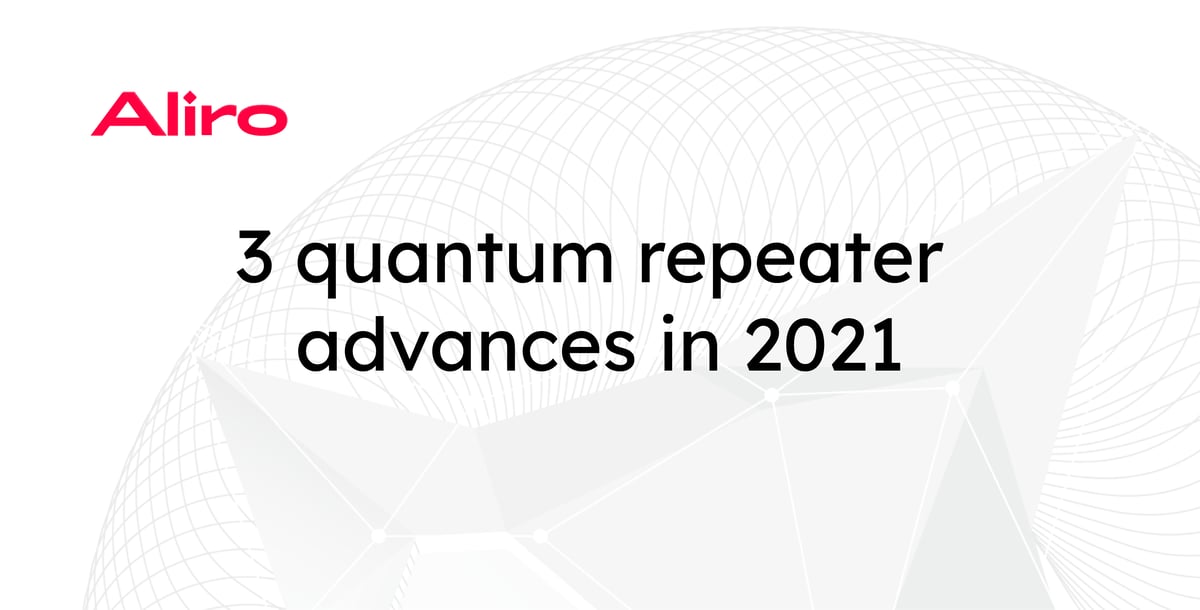
Because quantum states are highly susceptible to noise from the environment, quantum entanglement has historically been achieved only over limited distances. Luckily, quantum repeaters offer a way to extend entanglement over long distances. Quantum repeaters have the potential to solve one of the most central challenges in quantum networking. And progress towards practical repeaters is happening fast. Just this year, there have been three different major demonstrations of key technology that will impact quantum repeater development going forward.
Do quantum repeaters exist yet?
The short answer is not yet. Today's quantum communication devices are not able to handle practical quantum network distances or rates, but lab experiments have already begun to show key functions that will be needed for entanglement-based quantum networks.
Three advances in quantum repeaters in 2021
This year has already seen three major technical advances in quantum repeater technology. First, a research group in Delft showed a multi-node quantum network. Then, just this month, researchers from Spain and China separately demonstrated key aspects needed for quantum repeaters.
1) Delft researchers develop multi-node quantum network
[Science] In April, QuTech researchers published their results in the journal Science showing that they had successfully built a 3-node quantum network using entanglement swapping. This result made major waves as it showed a crucial step in the development of quantum repeaters —building a true multi-node network based on the same protocols that can be used for networks of quantum repeaters.
Entanglement swapping
The first key demonstration from the QuTech research was the demonstration of entanglement swapping. The network contained three nodes: Alice, Bob, and Charlie, with links between Alice-Bob and Bob-Charlie. Using entanglement swapping, the researchers were able to establish entanglement between Alice and Charlie even though the nodes were not directly connected. This is the key concept behind quantum repeaters. More nodes can be added, extending entanglement over even longer distances without the need for direct physical connection.
Multipartite entanglement
The researchers went even further to demonstrate multipartite entanglement between all three nodes. They were able to create a true shared state across all three nodes. Multipartite entanglement is even harder to produce than direct entanglement, but has exciting applications, for example in distributed quantum sensing.
2) Spanish researchers show solid-state quantum repeater
[Nature] In June, Barcelona researchers showed heralded entanglement using multiplexed solid-state quantum memories. In contrast to the QuTech experiment, the network connected only two nodes. However, the researchers showed the entanglement using components that hold significant promise for practical quantum repeaters. Specifically, the paper notes the need for quantum repeaters to produce entanglement at high rates, with telecom wavelengths, and with long storage times. The solid-state memories used by the group achieve all of these goals, including the ability to store 62 temporal modes. The nodes were separated by 50 meters and a bell state measurement node used to complete the heralded entanglement.
See a short video posted here by the researchers explaining their work. [5min]
3) Chinese researchers construct a quantum repeater based on absorptive quantum memories
[Nature] Simultaneously, Chinese researchers have made a similar leap towards more practical technologies for heralded entanglement. In this work, the researchers used "absorptive" quantum memories, which have the properties of high bandwidth, high fidelity and multiplexing capacity. Similar to the Barcelona group, the researchers built a two node network separated by a heralding station. This paper joined the Spanish paper on the cover of the journal Nature in June.
Longer distances, bigger networks
What's next after these experiments? The answer is clear: all three research groups described plans of building on their progress to build networks across longer distances with additional nodes. Ultimately, the goal is to use these same techniques to build quantum networks that span between cities and ultimately to the global quantum internet.
If you enjoyed this blog and would like to stay up to date as future developments in quantum communication take place, please sign up for our monthly newsletter, The Quantum Connect, in the footer of this page.
